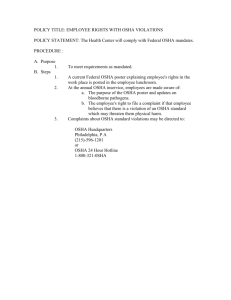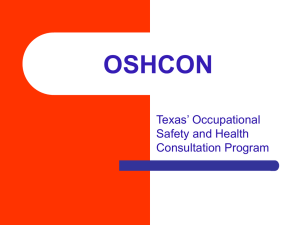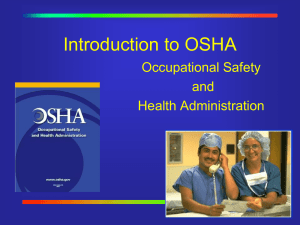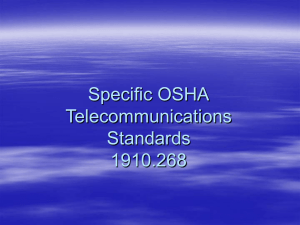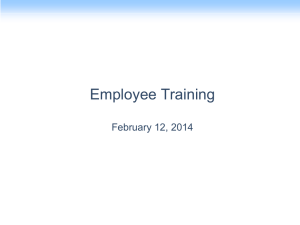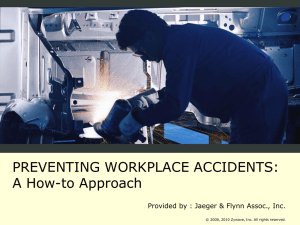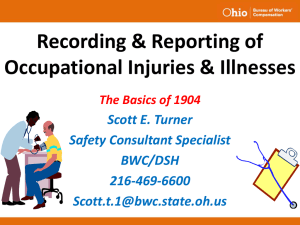DIOSH recordkeeping 2013
advertisement
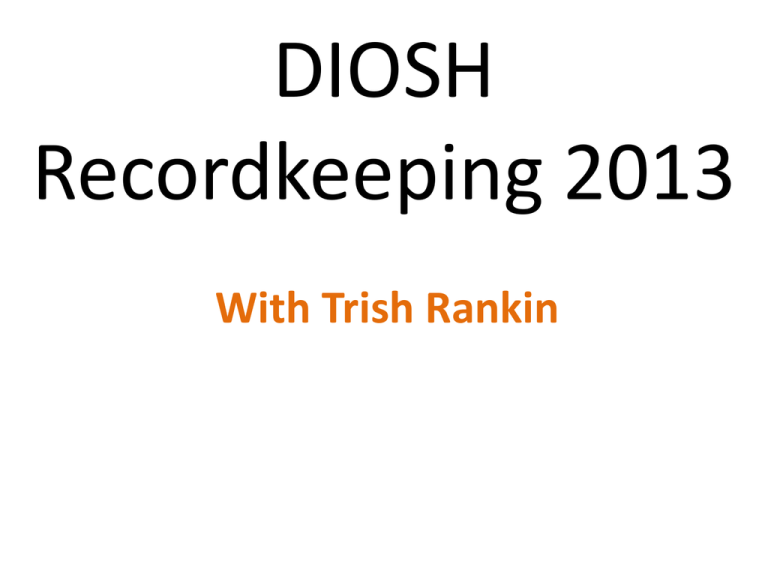
DIOSH Recordkeeping 2013 With Trish Rankin Topics and fun • Yes, there is a test • Where to find information • All things not recordable • Things that get confusing • Practice recording www.osha.gov Nine Exceptions 1. Present as a member of the general public. 2. Symptoms arising in work environment that are solely due to non-work-related event or exposure. 3. Voluntary participation in wellness program, medical, fitness or recreational activity. 4. Eating, drinking or preparing food or drink for personal consumption. Nine Exceptions 5. Personal tasks outside assigned working hours. 6. Personal grooming, self medication for non-work-related condition, or intentionally self-inflicted. 7. Motor vehicle accident in parking lot/access road during commute. 8. Common cold or flu. 9. Mental illness unless medical opinion states work related. Medical treatment is the management and care of a patient to combat disease or disorder. It does not include: • Visits to licensed health care professional solely for observation • Diagnostic procedures • First Aid First Aid • • • • Using nonprescription medication at nonprescription strength Tetanus immunizations Cleaning, flushing, or soaking surface wounds • • • Wound coverings, butterfly bandages, Steri-Strips; glue? Hot or cold therapy Non-rigid means of support – braces? Temporary immobilization device used to transport accident victims First Aid • Eye patches • Removing foreign bodies from eye using irrigation or cotton swab • Removing splinters or foreign material from areas other than the eye by irrigation, tweezers, cotton swabs or other simple means • Drilling of fingernail or toenail, draining fluid from blister Finger guards • Massages • Drinking fluids for relief of heat stress • Single dosages considered prescription strength for common over-the-counter drugs: • Ibuprofen (Advil™) – – Greater than 467 mg • Diphenhydramine (Benadryl™) – – Greater than 50 mg • Naproxen Sodium (Aleve™) – – Greater than 220 mg • Ketoprofen (Orudus KT™) – – Greater than 25mg Restricted Work / Job Transfer 1904.7(b)(4) • Employee is kept from performing one or more of the routine functions (at least once a week) that he or she would otherwise have been scheduled to work. • or • An employee is kept from working a full workday Day counts • Day zero = day of injury or diagnosis • Any day off work or restricted is a day. • Day of release does not count. Also.. • Loss of consciousness – recordable? • Administering of Oxygen – Precautionary or – Medical treatment • Braces ridged and non ridged • Knee immobilizer vs knee brace 1. Which one of the following statements is absolutely true? • a. Any employer that has 11 employees is required to keep an OSHA 300 form. • b. Any facility in existence for more than a year is required to post an OSHA 300A. • c. There is a list of exempt standard industrial codes in the recordkeeping standard that do not have to keep the OSHA form 300. • d. When determining the number of employees for recordkeeping purposes, you do not have to count temporary employees. 2. Which instance would likely be recorded on the OSHA 300 form? • a. An employee coming to work, crossing a public street prior to their shift, is struck by vehicle and is hospitalized for her injuries. • b. Employee breaks his ankle during the lunchtime pickup basketball game. • c. An employee wearing a dust mask (N95) has heart attack and died while shoveling material on a hot and humid day. • d. An employee spilled his coffee on his hand resulting in burns requiring medical treatment. 3. Which instance would have to be recorded on the OSHA 300 form? • a. An employee feels threated by their boss and missed work for 3 days. • b. Your employee twists his ankle playing ultimate Frisbee for Joe’s bar team and returns to work with a doctor’s restriction that he cannot stand at work. • c. An employee driving to a work related training session at noon in his own vehicle is struck and killed by a drunk driver. • d. A diabetic office employee suffers a convulsion and broken clavicle as a result of striking his shoulder on chair during a spell. 4. Which instance would have to be recorded on the OSHA 300 form? • a. An employee stepped on a nail and received a tetanus shot • b. An employee put ice on his shoulder every day after shoveling grain. • c. The secretary at the facility uses liquid adhesive/ medical glue to close a two centimeter cut on a workers palm. • d. An employee got dust in his eyes and went to the local hospital and had it flushed out with water by the emergency room doctor. 5. Which instances (2) would not have to be recorded on the OSHA 300 form? • a. A doctor prescribes employee 800 mg of ibuprofen every 2 hours for back injury. • b. A lumberjack is given a rigid splint for his little finger when injured by a branch. • c. Neanderthal Ned from the landscaping company has a podiatrist drill a hole in his toenail to relieve pressure from the swelling after dropping a 12 pound rock on his big toe. • d. The boss pays for an employee complaining of neck pain to get a neck and back massage at a local chair massage station. 6. Which one of the following statements is absolutely true? • a. A work related fatality must be reported to the local OSHA office in 24 hours. • b. An employee with any medical restriction is required to be documented on the OSHA 300 form. • c. An employer has 7 calendar days to update information on the OSHA 300 log. • d. The Safety Director is responsible for signing the OSHA 300A annual summary. 7. Which instance would not have to be recorded on the OSHA 300 Log? • An employee pinches his finger at work and goes to the Doctor the following day for an x-ray. The Doctor tells the employee not to return to work until the results of the x-ray are known. The employee misses a full day of work even though the x-ray was negative. • An employee has been diagnosed with carpal tunnel syndrome. • An employee has a non-work-related pre-existing condition (hernia). The employee suffers an injury while pulling on a pipe wrench at work resulting in pain and had to have hernia surgery the same day as the injury. • An employee suffers a new work-related injury and is currently taking prescription medication for a different non-work-related injury. The Doctor tells the employee to continue taking the prescription medication for the workrelated injury or illness.

